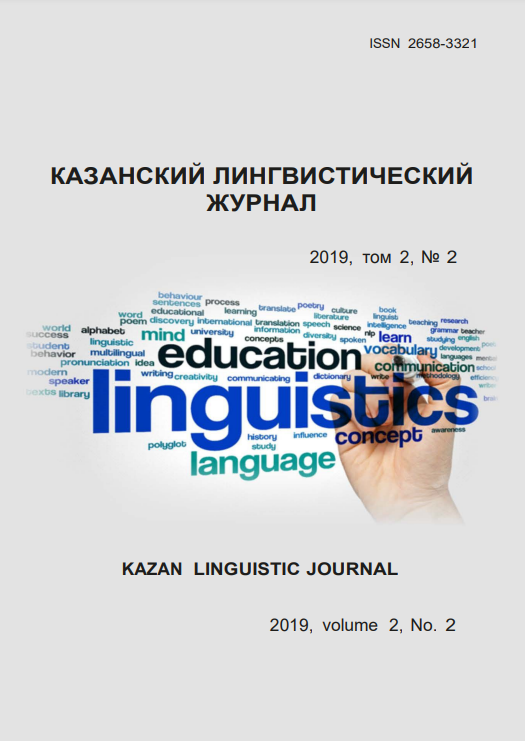Communicative orientation of the course in Turkish language
Keywords:
Turkish language, traditional methods, communication skills, innovative technologiesAbstract
The article examines the basic methods and techniques used to improve communication skills of the students learning Turkish language. Based on the student's educational orientation; active interaction and communication, motivation, information, innovation and selection of materials especially learning and communication skills are important components of the process. What methods are the most effective development of speech skills is studied. The learning of foreign language is successful only with the using of communication process. Communication- oriented teaching is the theme of research, improvement and foreign language teaching applications development both in Russia and abroad. The researches of foreign and Russian language experts are included.
References
Литература
Ачан Н. М. Использование возможностей сети Интернета при изучении турецкого языка / Н. М. Aчан, М. Л. Ланских // Уральское
востоковедение: международный альманах. Екатеринбург: [Изд-во Урал. ун-та], Вып. 6. 2015. С. 261-269.
Гукова Е. Деятельность ЮНЕСКО по сохранению языкового разнообразия. Документальный аспект // URL://http://mgs.org.ru/2013/12/gukova/ (accessed: 01.12.2013).
Колшанский Г. В. Лингвокоммуникативные аспекты речевого общения. // Иностранные языки в школе. № 1. 1985. С. 10–14.
Молодых-Нагаева Е.Г., Чувильская Е.A. Иностранный язык в неязыковом вузе: как мотивировать студента? // Современные проблемы науки и образования. №5. 2014. С. 80-90.
Пассов Е.И., Кузовлева Н.Е. Основы коммуникативной теории и технологии иноязычного образования. Методическое пособие для преподавателей русского языка как иностранного, Москва. 2010.
Хасаншина Р.Г. О некоторых аспектах обучения говорению студентов неязыковых вузов [Текст] / Р. Г. Хасаншина // Вестн. ТИСБИ. Казан, № 2. 2005. C 142–154.
Jacobs G., Farrell T. Understanding and Implementing the CLT (Communicative Language Teaching) Paradigm [Электронный ресурс] / RELC Journal, 34.1, Singapore, 2003. // URL: http://journals.sagepub.com/doi/abs/10.1177/003368820303400102 (accessed: 13.12.2016). Pp.6-30.
References
Achan, N. M. (2015). Ispol'zovanie vozmozhnostej seti Interneta pri izuchenii tureckogo yazyka [Using the power of the Internet when learning Turkish] /
N. M. Achan, M. L. Lanskih // Ural'skoe vostokovedenie: mezhdunarodnyj al'manah. Ekaterinburg: [Izd-vo Ural. un-ta], Vyp. 6. S. 261 – 269. (In Russian)
Gukova, E. Deyatel'nost' YUNESKO po sohraneniyu yazykovogo raznoobraziya. Dokumental'nyj aspekt [UNESCO action to preserve linguistic diversity. Documentary aspect] // URL://http://mgs.org.ru/2013/12/gukova/ (accessed: 01.12.2013). (In Russian)
Hasanshina, R. G. (2005). O nekotoryh aspektah obucheniya govoreniyu studentov neyazykovyh vuzov [On some aspects of teaching non-linguistic students to speak] / R. G. Hasanshina // Vestn. TISBI. – Kazan, № 2, s 142–154. (In Russian)
Jacobs, G., Farrell, T. (2003). Understanding and Implementtng the CLT (Communicative Language Teaching) Paradigm / RELC Journal, 34.1, Singapore. // URL: http://journals.sagepub.com/doi/abs/10.1177/003368820303400102 (accessed: 13.12.2016). Pp.6–30. (In English)
Kolshanskij, G. V. (1985). Lingvokommunikativnye aspekty rechevogo obshcheniya [Linguocommunicative aspects of speech communication] // Inostrannye yazyki v shkole. № 1. S. 10–14. (In Russian)
Molodyh-Nagaeva, E. G., CHuvil'skaya, E. A. (2014). Inostrannyj yazyk v neyazykovom vuze: kak motivirovat'studenta? [Foreign language in a non-linguistic university: how to motivate a student?] // Sovremennye problemy nauki i obrazovaniya. №5. S. 80–90. (In Russian)
Passov, E.I., Kuzovleva, N.E. (2010). Osnovy kommunikativnoj teorii i tekhnologii inoyazychnogo obrazovaniya [Basics of communication theory and technology of foreign language education.]. Metodicheskoe posobie dlya prepodavatelej russkogo yazyka kak inostrannogo. Moskva. (In Russian)






